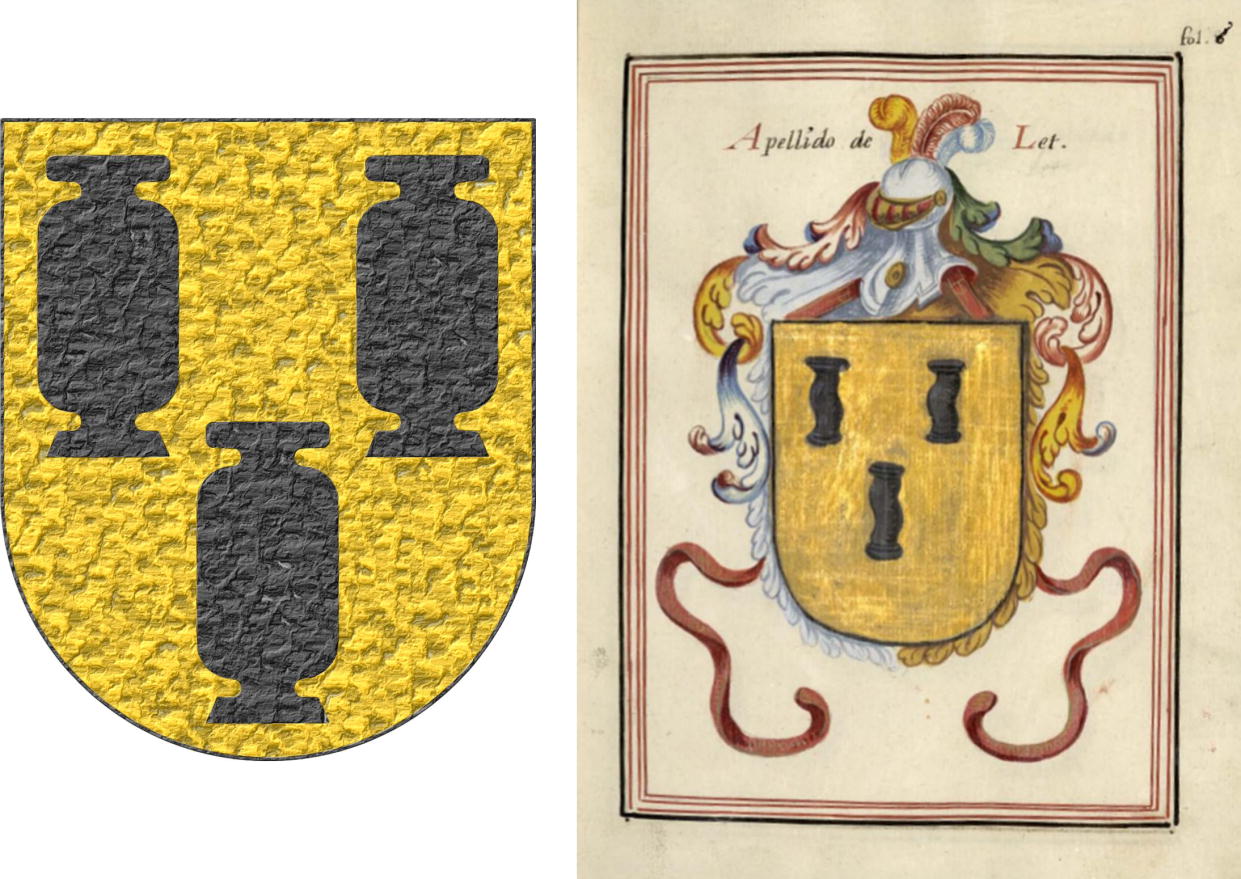Canting arms


Appleton, David B.
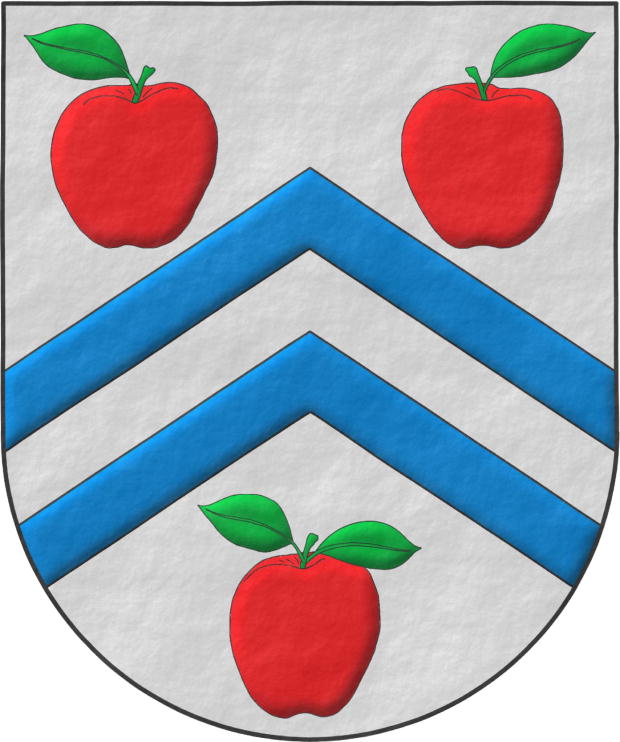
Canting arms, apple ~ appleton.
Argent, two chevronels Azure between three apples Gules, slipped and leaved Vert.
Escudo de plata, dos tenazas de azur acompañadas de tres manzanas de gules, talladas y hojadas de sinople.
Coat of arms interpreted by me with: a round-bottomed shield shape; the field in flat tincture metal Argent; the figures outlined in Sable and illuminated in Azure, Gules, and Vert; and all with a rough finish.
A summary of the heraldic blog of David B. Appleton can be found among my recommended links on the heraldic universe.
Blazon keywords: Without divisions, Argent, Azure, Gules, Vert, Chevronel, Between, Apple, Slipped and Leaved.
Style keywords: Rough, Illuminated and Outlined in sable.
Classification: Interpreted, Personal, Coat of arms, Canting and Heraldry and heralds.
Bearer: Appleton, David B..


Castile and León on parchment
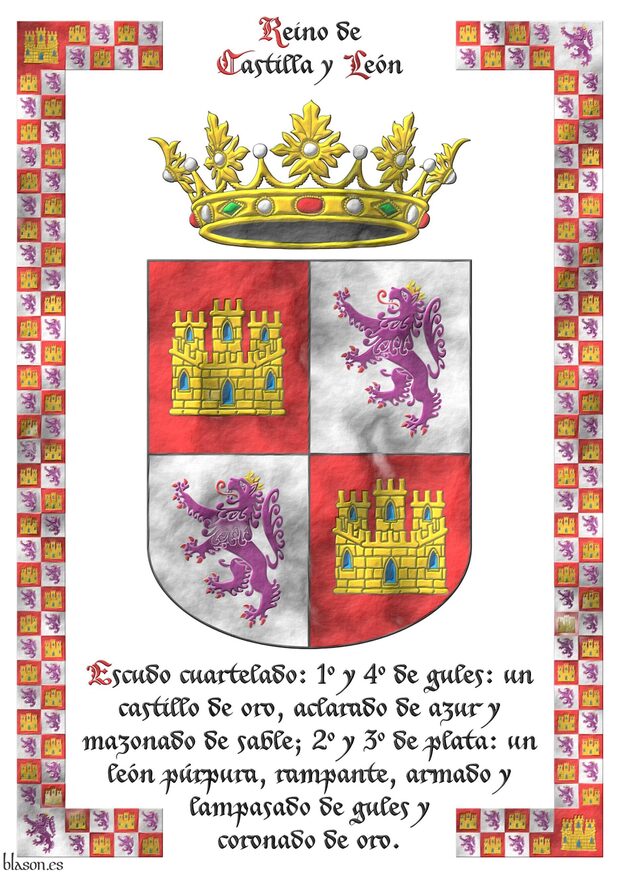
Quarterly: 1 and 4 Gules, a castle triple towered Or, port and windows Azure, masoned Sable; 2 and 3 Argent, a lion rampant Purpure, armed and langued Gules, crowned Or. Crest: An open royal crown Or.
Escudo cuartelado: 1o y 4o de gules, un castillo de oro, aclarado de azur, mazonado de sable; 2o y 3o de plata, un león rampante de púrpura, armado y lampasado de gules, coronado de oro. Timbrado de una corona real abierta.
Arms of the Kingdom of Castile and León which I have interpreted as follows: the shield has a rounded (semicircular) base; the quarters are illuminated in flat tinctures Argent and Gules; the castles, lions and crown are illuminated; the lion and its crown are outlined in the colour of the field; the open royal crown; the royal Castilian castle is outlined in Sable, which is said to be masoned; the owner, the shield and its blazon are framed within a border also representing the arms of the Kingdom, this frame being formed by 76 small castles and 2 large ones in two corners, and 76 small crowned lions and 2 large ones in the other two corners; and the whole set appears as if illuminated upon an old parchment.
Blazon keywords: Quarterly, Gules, Or, Azure, Sable, One, Castle, Port and windows, Masoned, Argent, Purpure, Lion, Rampant, Armed, Langued, Crowned, Crest, Open royal crown and Crown.
Style keywords: Rounded, Illuminated and Old parchment.
Classification: Interpreted, Civic, Frame, Kingdom of Castile and Leon and Canting.
Bearer: Castile and León.


Herndon, family of Paul and Kari

Argent, a heron volant Azure, beaked and membered between three escallops Sable.
Escudo de plata, una garza volante de azur, picada y membrada, acompañada de tres veneras todo de sable.
Arms painted by me, illuminated with lights and shadows, outlined in Sable, with a pointed external shape and with a rough finishing.
Canting arms of the family of Paul and Kari Herndon, based on the arms of their lineage, and emblazoned by me.
Blazon keywords: Argent, Azure, Sable, One, Three, Heron, Volant, Beaked, Membered, Between and Escallop.
Style keywords: Outlined in sable, Illuminated, Pointed and Rough.
Classification: Personal, Canting, Interpreted, Boa and Coat of arms.
Bearer: Herndon, family of Paul and Kari.


Lete of Navarre
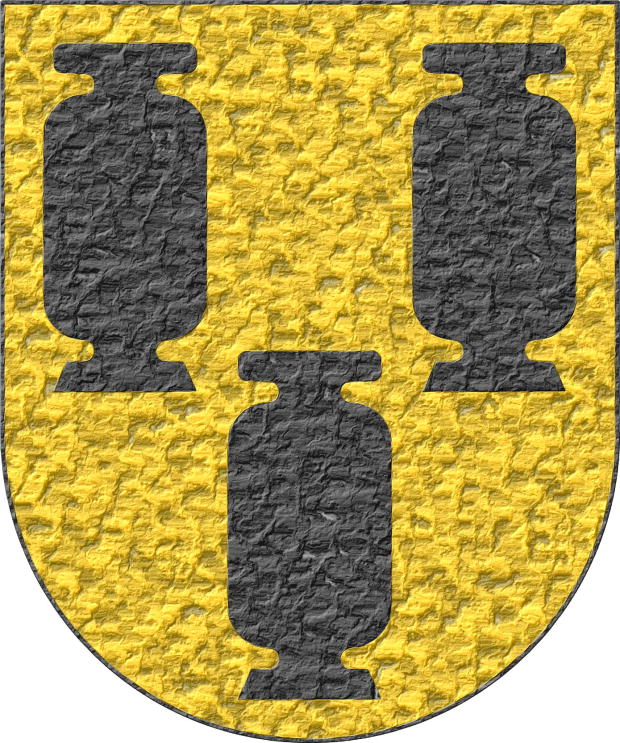
Of the twelve lineages of Noblemen, the sixth is that of Lete, from which descended Don Juan Corbarán de Let: they bear as arms, on a field Or, three pots shaped like cauldrons, slightly elongated, as painted in this shield.
Or, three Fleshpot Sable.
Escudo de oro, tres potes de sable.
Coat of arms interpreted with: a semicircular (round) base; the field in flat Or metal; the three pots illuminated in Sable with vertical, but not horizontal symmetry; and finished in highly-hammered metal.
It is not easy to find in English a similar figure:
- it could be considered «pote» ~ «pot», although perhaps «pot» is too generic,
- another possibility is «pote» ~ «fleshpot», which, although usually represented with three legs instead of a base and with two handles, is the one I tend to prefer,
- the English term «cauldron», but this corresponds to our «caldero» ~ «cauldron».
Coat of arms based on the sixth of the Navarrese «ricoshombres» from [Bosque, J. del; 1540; folio 1 of the numbering of 1613]. The text heading this article is taken from the transcription made by [Martinena Ruiz, J. J.; 1982; pages 122 and 123].
Although I have not found any reference about it, it could be considered that originally they might have been canting arms and that these three «potes» could have been milk pots, in reference to their bearers «Lete».
Under the title «Surname of Let» it can also be consulted in [Vega, P. J. de; 1702; folio 6 of the manuscript], although the number has been altered, possibly having been a 5 and perhaps interpreted as an 8, it is deduced by being placed after folio 7.
Blazon keywords: Without divisions, Or, Clay pot and Sable.
Style keywords: Semi-circular, Illuminated and Hard metal.
Classification: Interpreted, Personal, Kingdom of Navarre and Canting.
Bearer: Lete of Navarre.


Lopez Linares, Barbaro Jonathan

Azure, a wolf's head caboshed Argent, in chief three monstrances in fess proper.
Escudo de azur, una cabeza de frente de lobo de plata, acompañada en jefe de tres custodias en faja al natural.
Arms depicted by me, illuminated with lights and shadows, contoured in Sable, with a rounded trapezoidal outer contour and with a metal and iridescent finishing.
Coat of arms of Barbaro Jonathan Lopez Linares, Cuba, designed by him and emblazoned by me. In English heraldry the term caboshed applies to the head of any animal shown affronty, but it always refers only to the head, with no part of the neck visible; for example, one may blazon «a bull’s head caboshed» or «a wolf’s head caboshed», whereas if the neck is shown the proper term is «a bull’s head couped affronty»; in other words, a head caboshed does not show any of the neck, it is just the animal’s face; this usage of caboshed is valid both for horned animals such as the stag, the goat, or the bull, and also for hornless animals such as the wolf; in Castilian heraldry, however, [Cadenas y Vicent, V. de; 2002] defines «reencuentro» specifically for the frontal head of the bull, and by extension for other horned animals such as the stag or the goat; thus, for a wolf, one should properly blazon simply «una cabeza de lobo de frente» ~ «a wolf’s head affronty»; finally, the [Real Academia Española; 2014] standardizes the spelling «reencuentro» with double «e», although it also accepts the shorter variant «rencuentro», which is the one I personally prefer to use. In heraldry, when a monstrance is blazoned proper, it is understood that the entire structure of the object is of the metal Or, with its characteristic details such as rays, sunburst, or base also in gold, and that inside it the Host is visible in Argent; therefore, a «monstrance proper» must always appear in gold with the silver Host at its center.
Blazon keywords: Azure, Argent, One, Three, Wolf, Head, Caboshed, In chief, Monstrance, Proper and Motto.
Style keywords: Outlined in sable, Illuminated, Rounded trapezoid and Metal and iridescent.
Classification: Personal, Interpreted, Canting, Boa and Coat of arms.
Bearer: Lopez Linares, Barbaro Jonathan.


Marcio Vieira Nastri, hand-drawn
Heraldic badge of Marcio Vieira Nastri designed by him and emblazoned by me. It is a canting badge. The image combines a photograph of a drawing of a ribbon shaped like an «M», together with his badge, both painted by me. The insignia of Marcio Vieira Nastri features a «vieira», a escallop in Portuguese and Spanish, alluding to his surname Vieira. It also includes ribbons, since his surname Nastri means ribbons in Italian; they are Sanguine doubled Or, as in his mantling. The ribbons embrace the scallop in such a way that they resemble a capital M, for his name Marcio.
Blazon keywords: Or, Sanguine, Escallop and Ribbon.
Style keywords: Outlined in sable and Illuminated.
Classification: Personal, Canting, Interpreted, Boa, Hand-drawn, Collage and Photographic.
Bearer: Nastri, Marcio Vieira.


Mauleón of Navarre
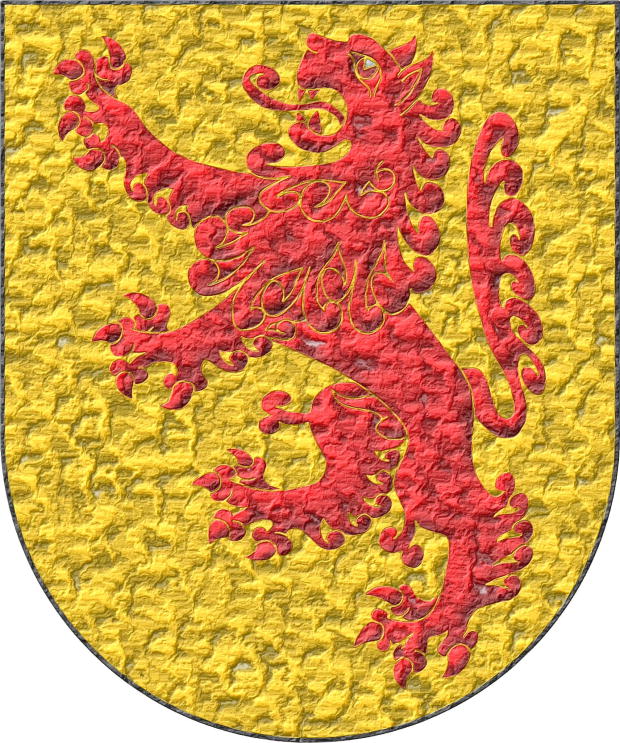
Of the twelve lineages of Noblemen, the twelfth bears as insignia and arms, on a shield Or, a rampant lion Gules, as painted in this shield.
Or, a Lion Gules, rampant.
Escudo de oro, un león de gules, rampante.
Coat of arms interpreted with: a semicircular (round) base; the field in flat Or; the lion illuminated in Gules and outlined in the colour of the field, that is, in Or metal; and the whole finished in highly-hammered metal.
Coat of arms interpreted from the last of the shields of the Navarrese «ricoshombres» illustrated in [Bosque, J. del; 1540; folio 1 of the numbering of 1613] and with the text preceding the blazon taken from the transcription by [Martinena Ruiz, J. J.; 1982; pages 122 and 123].
I consider these to be canting arms, and that this «lion» Gules refers to its bearers «Mauleón».
Under the title «Surname of Mauleon», without an accent on the letter «o», it can be consulted in [Vega, P. J. de; 1702; folio 12 of the manuscript].
Blazon keywords: Without divisions, Or, Lion, Gules and Rampant.
Style keywords: Semi-circular, Illuminated, Outlined in sable and Hard metal.
Classification: Interpreted, Personal, Kingdom of Navarre and Canting.
Bearer: Mauleón of Navarre.


Poumola, lineage of Catalonia
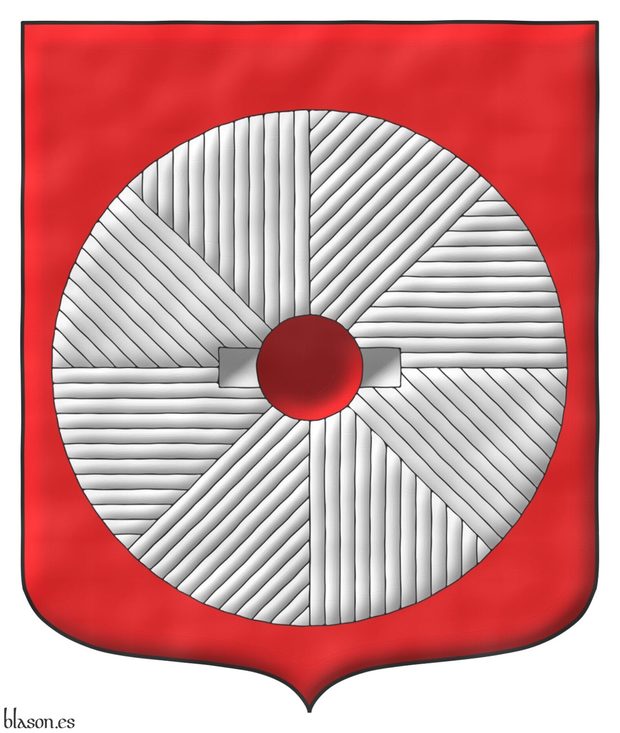
Blazon of the Poumola lineage of Catalonia.
Gules, a millstone Argent.
Escudo de gules, una piedra de molino de plata.
Illuminated and a watercolor finishing with shadow in the hole.
It blazon is describe in [Cadenas y Vicent, V. de; 1987; page 1429], [García Carraffa, A.; García Carraffa, A.; 1968; volume 3, page 358], and [Ferrer i Vives, F.; 1995; volume 2, page 362].
In this case, my theory is that this coat of arms is an example of «canting arms». «Canting arms» use a word or words of the surname or inside the surname to make the coat of arms. The surname Poumola is from Catalonia, we can split the surname into 2 parts «pou-mola», in Catalonian language a) «pou» means «well» and b) «mola» means «millstone» ~ «cadascuna de les dues pedres de forma circular que componen el molí», [GDLC; 1998], and this could be the reason of the symbolism of this coat of arms. «Canting» in heraldry means «talking» or «chatting», in Spanish «canting arms» is translated as «armas parlantes». Some heralds call «canting» to this creative technic.
Blazon keywords: Without divisions, Gules, One, Millstone and Argent.
Style keywords: Watercolor, Outlined in sable, Illuminated and Ogee.
Classification: Interpreted, Lineage and Canting.


Rodelo lineage from Galicia
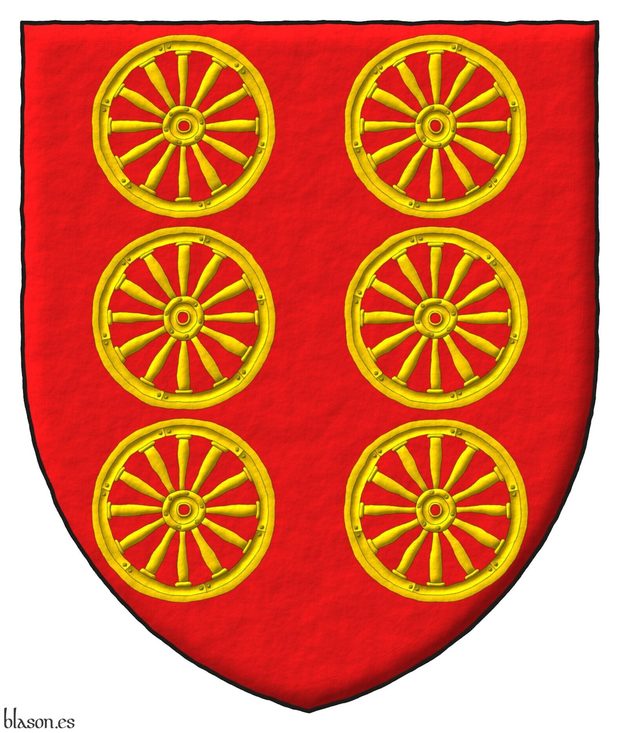
Gules, six wagon-wheels Or, 2, 2, and 2.
Escudo de gules, seis ruedas de carro de oro, 3 y 3.
Coat of arms emblazoned by me with a pointed ended shape, illuminated, and with a freehand finishing.
Another alternative way of writing this same blazon is the following: «Gules, six wagon-wheels Or, arranged in two pallets».
Blazon keywords: Gules, Six, Wagon-wheel and Or.
Style keywords: Outlined in sable, Illuminated, Freehand and Pointed.
Classification: Lineage, Interpreted, Canting and Coat of arms.
Bearer: Rodelo lineage from Galicia.


![Ver [Vega, P. J. de; 1702] en referencias bibliográficas. Libro abierto, hojas de plata, filo de oro, guardas de gules, tapas de sable.](../css/Libro.Bibliografia.png)
Vega, P. J. de; 1702
Pedro José de Vega, «Compendio de la Maior Parte Ð los Blassones, Armas, e Ynsignias Ð las Ylustres Casas, Familias, y Apellidos del Reyno Ð Navarra i Parte Ð la Provincia de Gvipvzcoa, Segvn las Vsan y Traen los Svccesores Ðellas» ~ «Compendium of the Greater Part of the Blazons, Arms, and Insignias of the Illustrious Houses, Families, and Surnames of the Kingdom of Navarre and Part of the Province of Guipuzcoa, As Used and Carried by Their Successors», manuscript in 2 volumes, Volume I, catalog number MSS/7835 V.1, and Volume II, catalog number MSS/7836 V.2, in the National Library of Spain, 1702.
As stated on the title page, the Field Master «Pedro Ioseph Ð Vega» was a native of the Kingdom of Navarre, deputy of the Kingdom of Navarre from 1688 to 1691, governor of the provinces of Cotabamba and Parinacochas in Peru, written as «governador», and gentleman of the «Voca de su Majestad» (His Majesty's Voice).
Bibliographical reference of century XVIII.
Author: Vega, Pedro José de.
The following articles cite this bibliographic reference:
- Almorrabides of Navarre
- Aybar of Navarre
- Baztanes of Navarre
- Guebara of Navarre
- Lete of Navarre
- Mauleón of Navarre
- Monteagudo of Navarra
- Navarra, emerald overall
- Qasqante of Navarre
- Rada of Navarre
- Subiça of Navarre
- Urroz of Navarre
- Vidaurre of Navarre
External resource:

William Shakespeare, lanza de torneo
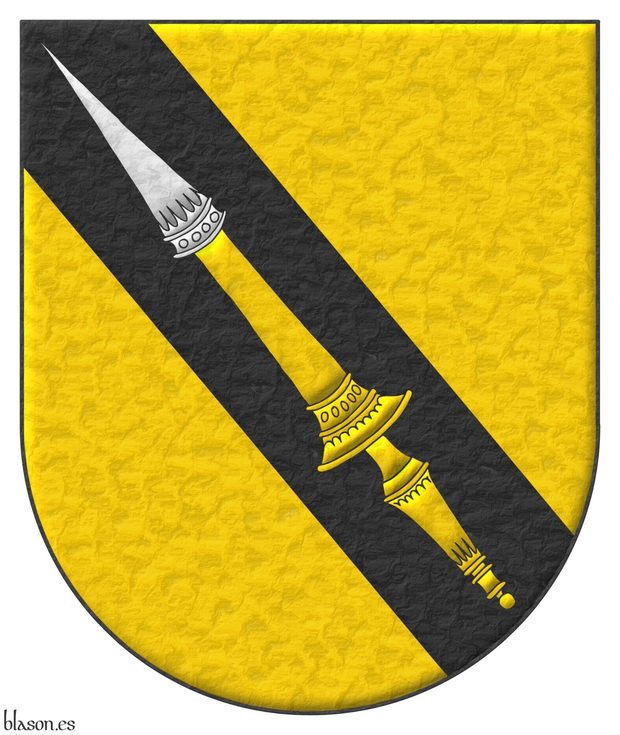
Or, on a bend Sable, a spear of the first, steeled Argent.
Escudo de oro, una banda de sable, cargada de una lanza de plata, fustada oro.
Coat of arms interpreted by me with: a semicircular (round) base; the field and bend illuminated in Or and Sable; the lance is a tournament one, similar to other Shakespeare coats of arms, which I have illuminated in Argent and Or and outlined from the field; and finished with a lightly hammered metal effect.
In this version of his blazon in English I have written «steeled Argent», which is how some authors write it, while in another article I have specified it as «headed Argent».
In the figure that is charged upon the bend of this interpretation of the shield, I recreate a tournament lance, which is the type usually used to represent the arms of William Shakespeare. Note that the blazon of his shield only indicates «a Spear» ~ «una lanza», so it could equally be the type of lance used by infantry or light cavalry. However, English tradition usually employs, for William Shakespeare, a tournament lance, both for the one charged on the bend and for the one held by the falcon on his crest.
Blazon keywords: Without divisions, Or, Sable, Argent, Bend, Bendwise, Spear and Charged.
Style keywords: Soft metal, Outlined in the field tincture and Illuminated.
Classification: Interpreted, Personal, Coat of arms, Canting and Literature.
Bearer: Shakespeare, William.
-
Language
-
Categories of heraldry
-
Divisions of the field
- Without divisions
- Party per pale
- Party per fess
- Party per bend
- Party per bend sinister
- Tierce
- Tierce sinister
- Tierced per pale
- Tierced per fess
- Tierced per bend
- Tierced pallwise inverted
- Quarterly
- Quarterly per saltire
- Gyronny
- Party per fess, the chief per pale
- Party per pale, the sinister per fess
- Party per fess, the base per pale
- Party per pale, the dexter per fess
- Chapé
- Chaussé
- Embrassé
- Contre-embrassé
- Party per chevron
- Enté
- Enté en point
- Flanched
-
Metals
-
Colours
-
Furs
-
Other tinctures
-
Ordinaries and sub-ordinaries
-
Diminutives of the ordinaries
-
Geometric charges
-
Composite ordinaries
-
Inanimate charges from Nature
Atom, Crescent, Diamond, Emerald, Estoile, Increscent, Lightning flash, Moon, Mount, Mullet, Mullet of four points, Orbital, Plough of Ursa Major, Rainbow, Ray of the sun, River, Sea, Snowflake, Sun, Sun in splendour, Sun of May, Trimount, Water and Wave.
-
Vegetal charges from Nature
Acorn, Apple, Apple tree, Ash, Bluebonnet, Camellia, Chrysanthemum, Cinquefoil, Cornflower, Dogwood flower, Double rose, Elm, Fleur de lis, Flower, Gourd, Holm oak, Hop cone, Kapok tree, Laurel, Lily, Linden, Lotus flower, Madonna lily, Mexican cedar tree, Oak, Olive tree, Palm tree, Plantain plant, Pomegranate, Poplar leaf, Rose, Shamrock, Sunflower, Thistle, Tree, Tulip, Vine and Wheat.
-
Animal charges from Nature
Badger, Bald eagle, Barbel, Barn owl, Bear, Beaver, Beetle, Bighorn sheep, Blackbird, Boar, Brach hound, Bull, Doe, Dog, Dolphin, Dove, Eagle, Elephant, Falcon, Female figure, Fish, Flame, Fly, Fox, Frog, Goat, Goldfinch, Goose, Heron, Horse, Hummingbird, Jaguar, Lark, Leopard, Lion, Lion passant, Lion rampant guardant, Lioness, Lynx, Male figure, Martlet, Merino ram, Owl, Panther, Parrot, Peacock, Pelican, Pelican in her piety, Puffin, Quetzal, Raven, Roe deer, Rooster, Savage, Seagull, Serpent, She-wolf, Stag, Starling, Talbot, Tyger, Vulture, Warren hound and Wolf.
-
Parts of natural charges
Arm, Beak, Branch, Caboshed, Chest, Claw, Covert, Dorsal fin, Eagle claw, Ermine spot, Escallop, Feather, Foot (palmiped), Foreleg, Forepaw, Hand, Head, Heart, Hoof, Leaf, Neck, Ostrich feather, Palm frond, Paw, Roe deers' attires, Shoulder, Sprig, Stags' attires, Stem, Swallow-tail, Tail, Tail addorsed, Tail fin, Talon, Tibia, Tooth, Trunk, Trunk (elephant), Two hands clasped, Two wings in vol, Udder, Wheat spike, Wing and Wrist.
-
Artificial charges
Ace of spades, Anchor, Anvil, Arch, Arm vambraced, Armillary sphere, Arrow, Axe, Bell, Bell tower, Beret, Bonfire, Book, Bookmark, Bow, Branding iron, Bridge, Broken, Buckle, Cannon, Cannon dismounted, Cannon port, Canopy roof, Carbuncle, Castle, Celtic Trinity knot, Chain, Chess rooks, Church, Clarion, Clay pot, Closed book, Club, Column, Comb, Compass rose, Conductor's baton, Cord, Covered cup, Crozier, Crucible, Cuffed, Cup, Cyclamor, Dagger, Double vajra, Drum, Ecclesiastical cap, Fanon, Federschwert, Fleam, Four crescents joined millsailwise, Galician granary, Garb, Gauntlet, Geometric solid, Grenade, Halberd, Hammer, Harp, Host, Hourglass, Key, Key ward, Knight, Knot, Lantern, Letter, Line, Loincloth, Menorah, Millrind, Millstone, Millwheel, Monstrance, Mortar, Mullet of six points pierced, Nail, Non-classic artifact, Norman ship, Number, Oar, Oil lamp, Open book, Page, Pair of scales, Parchment, Pestle, Piano, Pilgrim's staff, Plough share, Polish winged hussar, Port, Portcullis, Potent, Quill, Ribbon, Rosette of acanthus leaves, Sabre, Sackbut, Sail, Scroll, Scythe, Sheaf of tobacco, Ship, Skirt, Spear, Spear's head, Stairway, Star of David, Step, Sword, Symbol, Tetrahedron, Torch, Tower, Trident, Trumpet, Turret, Two-handed sword, Wagon-wheel, Water-bouget, Wheel, Winnowing fan and With a turret.
-
Immaterial charges
Angel, Archangel, Basilisk, Dragon, Dragon's head, Garuda, Golden fleece, Griffin, Heart enflamed, Justice, Mermaid, Our Lady of Mercy, Ouroboros, Paschal lamb, Pegasus, Phoenix, Sacred Heart of Jesus, Saint George, Sea-griffin, Trinity, Triton, Unicorn, Winged hand and Wyvern.
-
External elements
-
Heraldic creations
-
References
-
Formats
-
Keywords on this page
Port and windows, Between, Watercolor, Proper, Old parchment, Appleton, David B., Pointed, Armed, Azure, Bend, Bibliography, Boa, Head, Charged, Castile and León, Castle, Heraldry and heralds, Crest, Ribbon, Collage, Ogee, Crown, Open royal crown, Crowned, Quarterly, Monstrance, Outlined in sable, Outlined in the field tincture, Coat of arms, Personal, Gules, Illuminated, Interpreted, Lion, Lineage, Semi-circular, Hard metal, Or, Canting, Argent, Without divisions, Clay pot, Rampant, Kingdom of Navarre, Rough, Sable, Three, One and Escallop.


